If you’re curious about rosemary oil for hair growth, this detailed, step-by-step guide covers everything you need to know about how to make and use it! Read on for a deep dive into rosemary oil’s proven benefits for hair regrowth, thickening, and reducing hair loss. Plus, discover 3 easy ways to make rosemary hair oil: with herbal infusion, essential oils, or rosemary extract.

You’ve likely heard of the latest hair growth craze to sweep the internet: rosemary. From herbal infused oil to the ultra-trendy rosemary water, everyone seems to be dousing their hair in the aromatic herb.
But this isn’t just another over-hyped TikTok beauty tip – and it’s not a new discovery, either. Rosemary is a well-known natural hair growth remedy with plenty of evidence to support its efficacy, and making your own rosemary infused oil is one of the best ways to reap the benefits.
It’s wonderful to see natural solutions gain popularity. But while most people mean well, not all methods of making rosemary oil are effective or ideal.
That’s why I created this guide. When making rosemary oil for hair, using the right kind of rosemary, carrier oil, and infusion method is important to achieve the best results.
I’ll show you how to extract the most hair growth benefits from your infused oil, while also avoiding common mistakes.
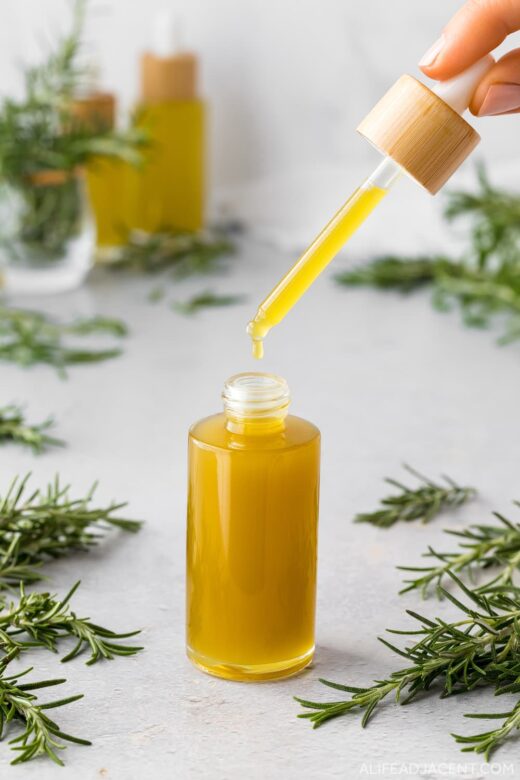
In this guide, you’ll discover:
- How to make rosemary oil for hair, including the best carrier oil and infusion method
- Rosemary benefits for hair and scalp health
- How to dilute rosemary essential oil for hair growth
- How to use this homemade remedy to encourage fast hair growth, improved thickness, and to help stop hair fall
Note: this is a long, info-packed guide. If you’re eager to get started, you might want to skip straight to the DIY, which includes step-by-step photos of the process. You can also find tips and a FAQ section at the end of this article.
- Why I made this rosemary hair oil recipe
- Rosemary oil for hair
- Rosemary infused oil vs rosemary essential oil
- Rosemary oil benefits for hair
- DIY rosemary oil for hair ingredients
- Notes on making rosemary oil
- Rosemary Hair Growth Oil Recipe
- How to dilute rosemary essential oil for hair growth
- How to use rosemary extract for hair
- How to use rosemary oil for hair growth
- Tips for using rosemary hair oil
- FAQ
Why I made this rosemary hair oil recipe
Many people seem to be experiencing hair loss these days, and if you’re on a hair regrowth journey, I’m right there with you.
I recently started ramping up my growth efforts after a period of stress-induced hair fall. In an effort to regain some length and thickness, I’ve been using homemade rosemary oil and rosemary water religiously.
While I still have a long way to go, it didn’t take much time to notice a difference – the excess shedding has stopped, and I’ve seen steady new growth.
Since I’ve found both remedies to be very helpful, I’ve also written a detailed guide to using rosemary water for hair. And if you struggle with a sensitive, irritated scalp, I also have a hair growth oil recipe with soothing willow bark and green tea.
Rosemary oil for hair
Rosemary oil refers to a carrier oil infused with rosemary leaves. Not to be confused with rosemary essential oil, this aromatic, herbal-infused oil has a variety of benefits for hair and scalp – especially growth and thickening.
The process of making rosemary oil for hair involves gently heating rosemary leaves with a carrier oil and antioxidant, then allowing the mixture to infuse for a couple weeks. This method yields a potent, fragrant, vibrant golden oil imbued with rosemary’s antioxidants and other beneficial compounds.
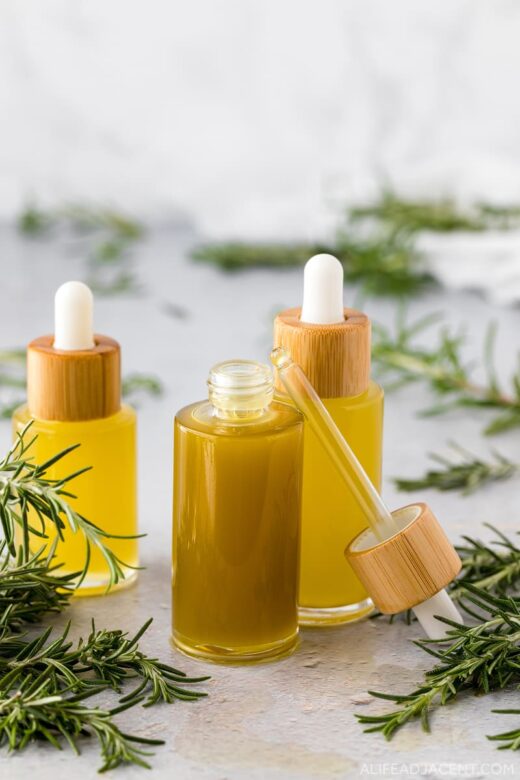
With its beautiful golden color, it’s like liquid gold for hair growth. But expect some natural color variation – the longer you infuse it, the stronger and darker it becomes, sometimes turning almost a golden-green hue.
Afterwards, DIY rosemary oil can be used directly on the scalp to help grow hair, improve thickness, and halt shedding. Or, it can be incorporated into other homemade hair growth recipes, such as:



Rosemary infused oil vs rosemary essential oil
So, what’s the best rosemary oil for hair growth?
While rosemary essential oil contains mostly aromatic compounds, rosemary infused oil contains a wide spectrum of lipid-soluble antioxidants, polyphenols, and fatty acids that aren’t present in the purified essential oil – all of which are very good for your hair.
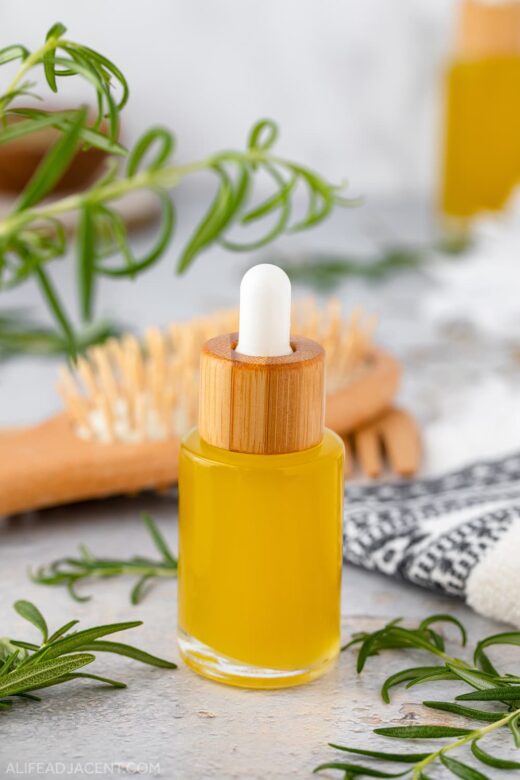
In terms of benefits, rosemary infused oil is likely best for growth. Still, that doesn’t mean the essential oil isn’t effective. If you don’t have rosemary herb, you can also dilute rosemary essential oil in a carrier oil to help stimulate hair growth (more on how to do this later). Alternatively, you can also use rosemary CO2 extract.
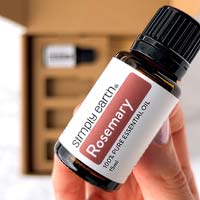
Another thing to note is that rosemary infused oil smells more like food (think delicious focaccia dipping oil), whereas the essential oil smells more medicinal.
But while it smells downright edible, I wouldn’t recommend using this rosemary oil recipe for culinary use.
Rosemary oil benefits for hair
Applied to the scalp, rosemary oil has been shown to help stimulate hair growth, stop hair fall, and even increase the size and number of hair follicles – quite literally thickening the hair1.
In fact, in a study comparing rosemary oil and minoxidil, both groups saw increased hair regrowth. However, rosemary was found to decrease hair loss even more so than the hair loss medication – without any of minoxidil’s side effects1.
There are a few main mechanisms by which rosemary oil helps grow longer, thicker hair: by stimulating scalp blood flow, decreasing inflammation1, downregulating hair loss hormones2, controlling yeast3, and protecting the hair and scalp’s lipids from oxidative damage4.
Let’s dive a little deeper into its benefits.
1. Stimulates hair follicle circulation
Rosemary oil potently stimulates scalp circulation, which is crucial for successful hair growth5. Blood flow delivers nutrients to the hair follicles, and well-nourished follicles grow longer, thicker hair.
Not only that, but effective circulation also encourages new hair follicles to grow, and also increases their size. So if you have thin or fine hair, using rosemary oil on your scalp can help increase thickness.

2. Anti-inflammatory and antioxidant activity
Rosemary oil contains a wide variety of antioxidants, such as carnosic acid4, rosmarinic acid, ursolic acid, caffeic acid, oleanolic acid, micromeric acid6, and betulinic acid7 – all of which have potent anti-inflammatory properties that help maintain a healthy scalp.
This is very important for growth too, as scalp health is directly tied to healthy hair growth.
Just as low antioxidant levels are associated with skin aging, it’s well-known that low scalp antioxidant levels are associated with hair loss and alopecia8. In fact, applying antioxidants to the scalp has been shown to help stop hair shedding9.
Aside from helping growth, rosemary’s potent antioxidants also help prevent lipid peroxidation on the hair and scalp. In other words, they help stop your sebum from going rancid. (Yes, this can happen.)
Rancid oils create free radicals and oxidative stress, which stresses and ages our hair follicles10. So preventing this is key for keeping the hair healthy and growing.
3. Downregulates hair loss hormones
Rosemary is a natural herbal alternative to DHT blockers11 – it contains compounds that block the conversion of DHT, an androgen associated with hair loss at high levels.
Specifically, the carnosic acid2, rosmarinic acid12, and ursolic acid13 in rosemary all inhibit 5a-reductase, the enzyme that converts testosterone into hair loss-causing DHT.
So, using a rosemary hair oil may help balance hormone levels in favour of hair growth, helping it grow long and strong.
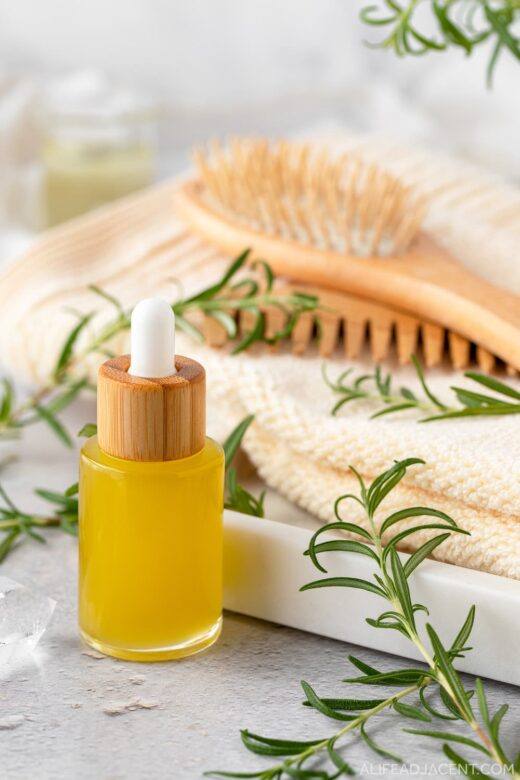
4. Reduces yeast, bacteria, and dandruff-induced hair fall
Left unchecked, yeast and bacteria on the scalp can work against your best hair growth efforts.
But rosemary’s potent antibacterial and anti-fungal properties help keep the scalp terrain in check, maintaining the optimal conditions to grow long, healthy hair.
In particular, rosemary helps inhibit Malasezzia3, a species of scalp yeast that can cause dandruff and hair loss when allowed to grow out of control8.
It also helps control acne-causing bacteria, helping keep pesky scalp pimples and the associated inflammation at bay14.
5. Nourishes, conditions, and strengthens the hair
Rosemary oil has nourishing and conditioning properties that promote soft, silky hair1.
Aside from antioxidants and flavonoids, rosemary leaves also contain phospholipids, glycolipids15, and fatty acids such as oleic acid and palmitic acid16.
These oily substances help nourish the hair, preventing breakage and keeping strands strong17. Because another facet of growing longer, thicker hair is keeping the hair you already have in good condition!
Still, this is barely covering rosemary’s many benefits for hair growth. To learn more, see my post on rosemary hair tea – it has even more benefits you can’t get from the oil.
DIY rosemary oil for hair ingredients
Making rosemary infused oil for hair is simple. You’ll need:
- Dried, organic rosemary leaves (not fresh)
- Castor oil and another carrier oil for dilution, such as MCT oil or fractionated coconut oil
- Vitamin E oil to protect the oil during infusion
Note: if you don’t have rosemary herb, you can also find 2 alternate hair oil recipes with essential oils or rosemary extract below.
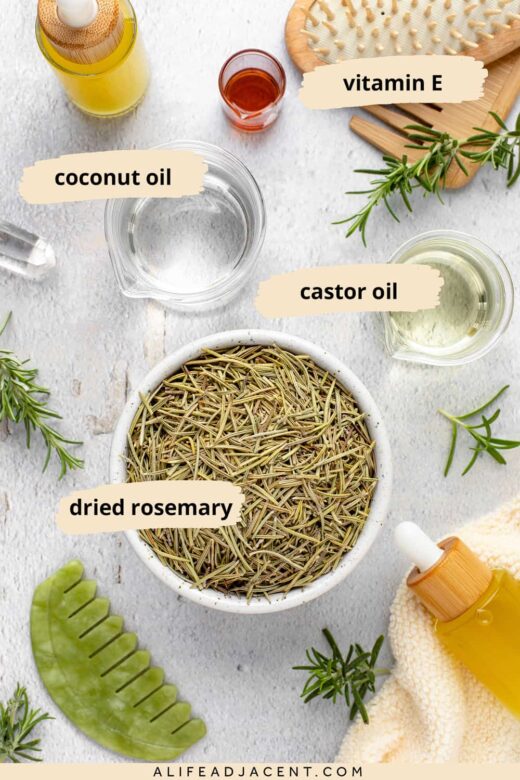
Organic rosemary
You’ll need a large amount of dried rosemary herb to make rosemary oil for hair. Dried organic rosemary is very affordable in bulk. I buy it by the bag and use it liberally to make hair oil, rosemary water, and other hair growth DIYs.
How much rosemary do you need to make rosemary oil? The short answer: a lot. I use approximately 3/4 cup dried organic rosemary leaves to 1 cup carrier oil for a strong, highly concentrated hair growth oil.
Organic is always best to avoid pesticide residue, but if it’s not available to you, regular dried rosemary is fine. Just be sure to buy dried whole leaves, not the small broken pieces you find in the spice aisle. And if you source culinary rosemary, you can use the leftover in food, too.
If you’d like to use fresh rosemary, it’s vital that you dry it first to avoid mold in your hair oil. For instructions, please see the FAQ section.

Carrier oils
This rosemary hair oil recipe calls for castor oil and fractionated coconut oil (or MCT oil).
It’s important to choose the right carrier oil for infused oils. Popular haircare oils such as sunflower oil, argan oil, and almond oil are extremely high in unstable PUFAs (polyunsaturated fatty acids), which are easily damaged and not suitable for heat infusion.
This is important, as oxidized oils are not good for our skin or hair – they use up antioxidants, which stresses the scalp and can even inhibit hair growth10.
Castor oil
Aside from being low-PUFA, cold-pressed castor oil has hair growth benefits of its own, including prostaglandin-like effects that directly modulate the growth cycle18.
It’s also abundant in growth-promoting vitamin E, and contains ricinoleic acid, a unique fatty acid that deeply nourishes the hair shaft17.
Many find straight castor oil difficult to use because of its highly viscous texture. But diluting it with another stable oil, such as fractionated coconut oil or MCT oil, solves this issue and makes it much easier to use (and wash out!).
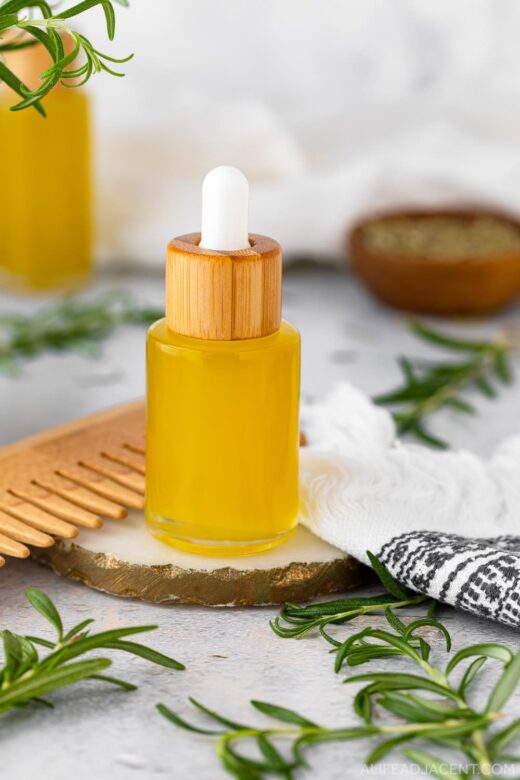
Fractionated coconut oil or MCT oil
Liquid coconut oil and MCT oil are two of the best carrier oils for heat infusing herbs. They’re comprised of mostly saturated fats, which makes them extremely heat-stable and gives them a long shelf life.
However, some hair types do not do well with these oils, especially protein sensitive hair. For some people, using coconut oil in excess may cause frizz or hair breakage.
In this case, low-PUFA monounsaturated oils such as jojoba oil, avocado oil, marula oil, and olive oil are other good choices to dilute your castor oil. More on the best low-PUFA skincare oils here.
Vitamin E
Vitamin E oil is a secret weapon for making herbal infused oils and other homemade hair growth treatments, including lash and brow serum.
Print
rosemary
Description
This Mango Key Lime Cheesecake has a coconut macaroon crust, layers of key lime and mango cheesecake and a mango cream and gelatin topping! It’s got no shortage of amazing layers and is full of amazing flavor!
Ingredients
Cookie Crust
3/4 cup (100g) vanilla wafer crumbs
- 2 tbsp (26g) sugar
- 2 tbsp (28g) butter, melted
Macaroon Crust
- 1 3/4 cups (131g) sweetened shredded coconut
- 1/4 cup (52g) granulated sugar
- 1/2 tsp vanilla extract
- 1/8 tsp salt
- 2 large egg whites, room temperature
Cheesecake Filling
- 24 ounces (678g) cream cheese, room temperature
- 1 1/4 cups (259g) sugar
- 3 tbsp (24g) all purpose flour
- 1 1/2 cups (360ml) sweetened condensed milk
- 1/2 cup (115g) sour cream
- 2 tsp coconut extract
- 2 tsp vanilla extract
- 4 large eggs, room temperature
- 1/2 cup (120ml) canned mango puree
- 2 1/4 tsp mango flavor
- 2 1/4 tsp mango extract
- 1/2 cup (120ml) key lime juice
Mango Cream Topping
- 2 large egg yolks
- 6 tbsp (78g) sugar
- 1 1/2 tbsp cornstarch
- 1 cup (240ml) milk
- 1 tbsp (14g) salted butter
- 3/4 tsp mango extract
- 3/4 tsp mango flavor
Mango Gelatin Topping
- 4 tbsp (60ml) room temperature water
- 1 1/2 tsp granulated gelatin
- 3 tbsp (39g) granulated sugar
- 1/2 cup (120ml) canned mango puree
Instructions
To Make The Crust
- Preheat oven to 325°F (163°C). Line a 9-inch (23cm) springform pan with parchment paper in the bottom and grease the sides.
- Combine the cookie crust ingredients in a small bowl. Press the mixture into the bottom of the springform pan.
- For the macaroon crust layer, add the shredded coconut, sugar, vanilla extract and salt to a large bowl, stir to combine and set aside. Add the egg whites to a large mixer bowl and whip on high speed until stiff peaks form. Fold about half of the egg whites into the coconut mixture, then add the remaining egg whites and fold together until well combined.
- Spread the macaroon mixture evenly over the cookie crust. Bake for 15-20 minutes or until the macaroon layer is lightly browned around the edges. Remove the crust from the oven and set aside to cool.
- Cover the outsides of the pan with aluminum foil so that water from the water bath cannot get in (see how I prepare my pan for a water bath). If the sides of your pan have gotten dirty and you don’t want that on the sides of your finished cheesecake, you can wipe the sides with a paper towel and then re-spray with non-stick spray. Set prepared pan aside.
To Make The Cheesecake Filling
- Reduce oven temperature to 300°F (148°C).
- In a large bowl, beat the cream cheese, sugar and flour on low speed until well combined and smooth. Be sure to use low speed to reduce the amount of air added to the batter, which can cause cracks. Scrape down the sides of the bowl.
- Slowly add the sweetened condensed milk and mix until well combined and smooth. Scrape down the sides of the bowl as needed.
- Add the sour cream, coconut extract and vanilla extract and mix on low speed until well combined.
- Add the eggs one at a time, mixing slowly to combine after each addition. Scrape down the sides of the bowl as needed to make sure everything is well combined.
- Divide the mixture evenly into two large bowls. I like to weigh the filling and then divide it evenly that way, but if you don’t have a food scale, you could measure it with cups.
- To one bowl add the mango puree, mango flavor and mango extract and gently stir together until well combined. To the other bowl, add the key lime juice and gently stir together until well combined.
- Pour the key lime filling onto the pre-baked crust and spread evenly. Add the mango filling on top of the key lime filling by drizzling it over and around on top of the key lime filling. Don’t just pour it all into one spot or it won’t create and more even layer.
- Place the springform pan inside another larger pan. Fill the outside pan with enough warm water to go about halfway up the sides of the springform pan. The water should not go above the top edge of the aluminum foil on the springform pan.
- Bake for 1 hour 15 minutes. The center should be set, but still jiggly. The outer 2-3 inches should be more set.
- Turn off the oven and leave the door closed for 30 minutes. The cheesecake will continue to cook, but slowly begin to cool as well.
- Crack the door of the oven for 30 minutes to allow the cheesecake to continue to cool slowly. This process helps prevent cracking.
- Remove the cheesecake from the oven and water bath wrapping and allow to cool to about room temperature. Refrigerate the cheesecake until firm, 5-6 hours or overnight. Remove the cheesecake from the springform pan and place on a serving dish. Refrigerate while you make the toppings.
To Make The Toppings
- To make the pastry cream, put the egg yolks in a medium sized bowl and gently beat them together. Set aside.
- Add the sugar, cornstarch and milk to a large saucepan and whisk together until smooth. Cook, stirring continuously, over medium heat until mixture begins to thicken and bubble.
- Add a little bit of milk mixture to the egg yolks and whisk together, then add a little bit more and whisk together. Add the egg mixture to the milk mixture. This process is called tempering and ensures that you don’t scramble the egg yolks. Place the pan back on the heat and bring to a light boil over medium heat.
- Allow to boil for about 1 minute, whisking continuously, until thickened.
- Remove from heat and add butter, mango extract and mango flavor. Stir until smooth and combined, then add it to the top of the cheesecake and spread evenly. Place back in the fridge while you make the final topping.
- To make the gelatin topping, add the water to a shallow dish. Sprinkle the granulated gelatin over the water so that it’s all touching water. Allow it to bloom for about 5 minutes.
- Heat the gelatin in the microwave for 5-10 seconds, until melted. Stir in the sugar, then add the mango puree to the gelatin mixture and stir to combine.
- Let the gelatin mixture sit for about 10 minutes to thicken slightly, then use a spoon to drizzle it over the top of the cream topping and then spread into an even layer.
- Refrigerate cheesecake until the topping layers are cool and firm, about 2-3 hours, then serve. Store cheesecake in an airtight container or well-covered in the fridge. It should be good for up to 4-5 days.
Notes
This is a thing
- dsfsadf
- sadsad
- asdsa
Adding it to your rosemary infused hair oil has a few key benefits. First, vitamin E is a powerful antioxidant that helps stabilize fats. It acts as insurance to help protect your oil’s fatty acids during heat infusion.
But it also has direct benefits for growing hair – when used topically, vitamin E was found to accelerate hair growth all on its own19. Much like rosemary, vitamin E stimulates blood flow, and its powerful antioxidants help revitalize and improve hair follicle health.
For best results, choose an amber colored vitamin E. Dark colored vitamin E oil contains a wider spectrum of tocopherols (the compounds that comprise vitamin E). The wider the spectrum, the more antioxidant benefits.
Notes on making rosemary oil
Before you make rosemary oil, here are a few notes about the process, shelf life, and tips for packaging.
Quantity, shelf life, and packaging
This recipe makes 1 cup (200g) rosemary hair oil. It’s easier to make larger amounts of infused oil, so feel free to double the recipe. The oil lasts a long time, and you’ll also have plenty of extra for homemade gifts.
For best potency, use your homemade rosemary oil within a year. However, this is a conservative guideline, as it will likely last up to 2 years – rosemary contains many antioxidants that slow oxidation, and vitamin E lengthens its shelf life even more.
Store rosemary infused oil in a cool, dark place. The best packaging is a dark glass dropper bottle, as this will protect it further from light. You can still use clear glass bottles if you’d like (like the bamboo dropper bottles pictured), but just be sure to store the oil in the dark between uses.
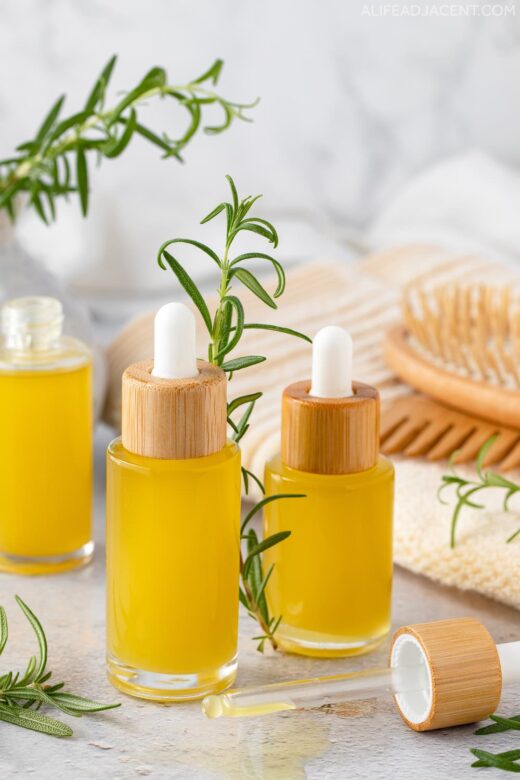
Herbal infusion process
There are a few basic steps to making rosemary infused oil: combining the dry herb and carrier oils, infusing with gentle heat, then allowing the mixture to further infuse at room temperature for a couple weeks. Double infusing the oil in this way gives it even stronger hair growth benefits.
Whichever container you use for infusion, please ensure it’s safe for the stovetop and has a lid. This saucepan with built-in pour spout is extremely handy.
Equipment + supplies
You’ll also need the following equipment and supplies:
- Small stainless steel pot with lid
- Laser thermometer
- Mason jar and lid for infusion
- Large sieve or cheesecloth to strain herbs
- Glass dropper bottle to apply hair oil
However, to make the simple rosemary oil with essential oils, you’ll need only a glass dropper bottle – instructions below.
Rosemary Hair Growth Oil Recipe
1/2 cup / 100g cold-pressed castor oil
1/2 cup / 100g fractionated coconut oil or MCT oil (see substitutions)
~3/4 cup dried rosemary leaves
5ml / 1 tsp / 4g mixed tocopherols vitamin E oil
How to make rosemary oil for hair
- Start by placing dried rosemary leaves in a small stainless steel saucepan or miniature double boiler. Then, pour castor oil and fractionated coconut oil (or another carrier oil such as jojoba oil) over top to cover the herbs.


- Add vitamin E oil to the mixture. Stir to incorporate and ensure the herbs are completely submerged in oil.
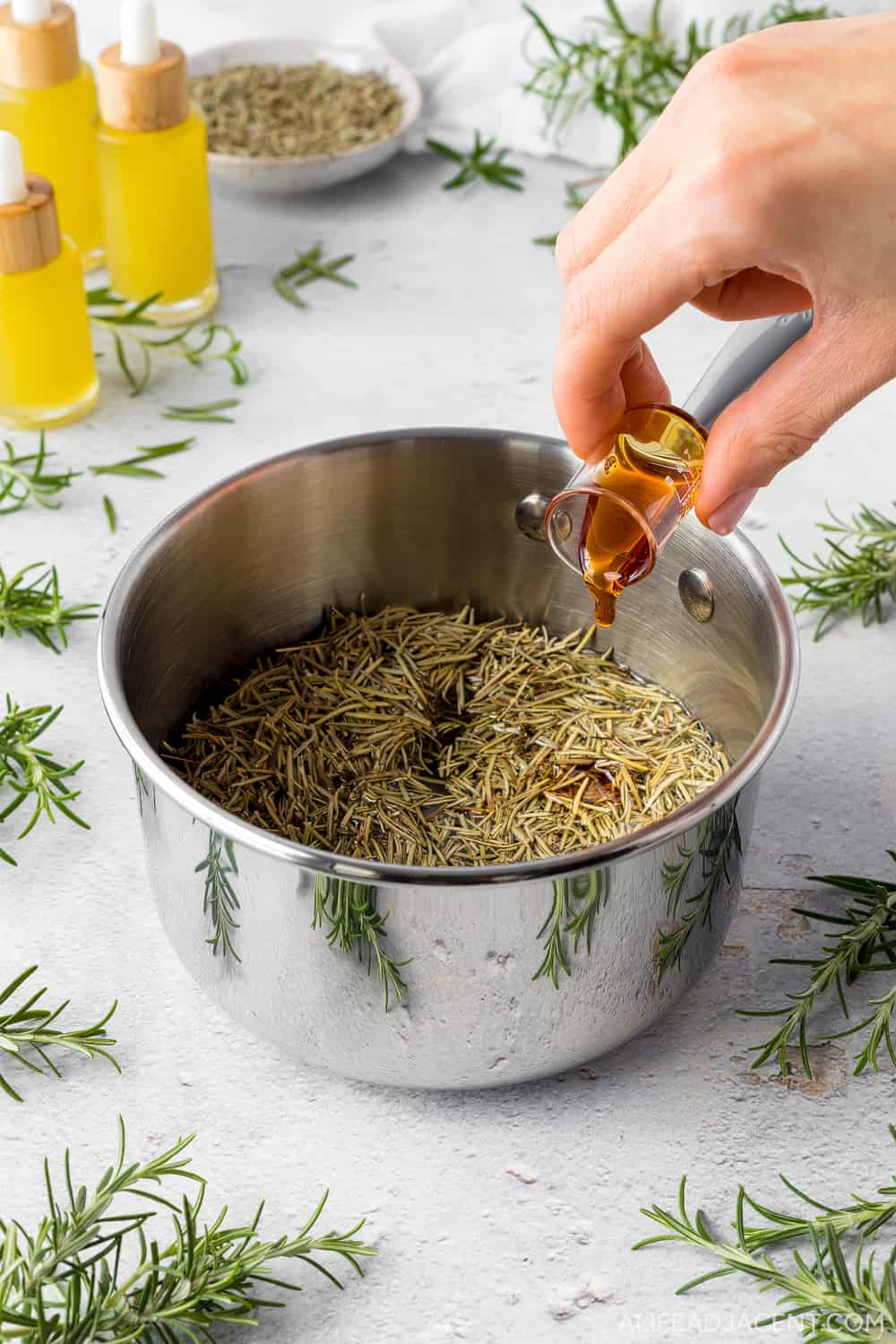

- Place the pot on the stovetop over medium-low heat, and keep your laser thermometer handy. The key is to extract as many benefits from the rosemary leaves as possible without overheating the oil. To keep from scorching the oil or herbs, please keep the rosemary oil from exceeding 110°C.
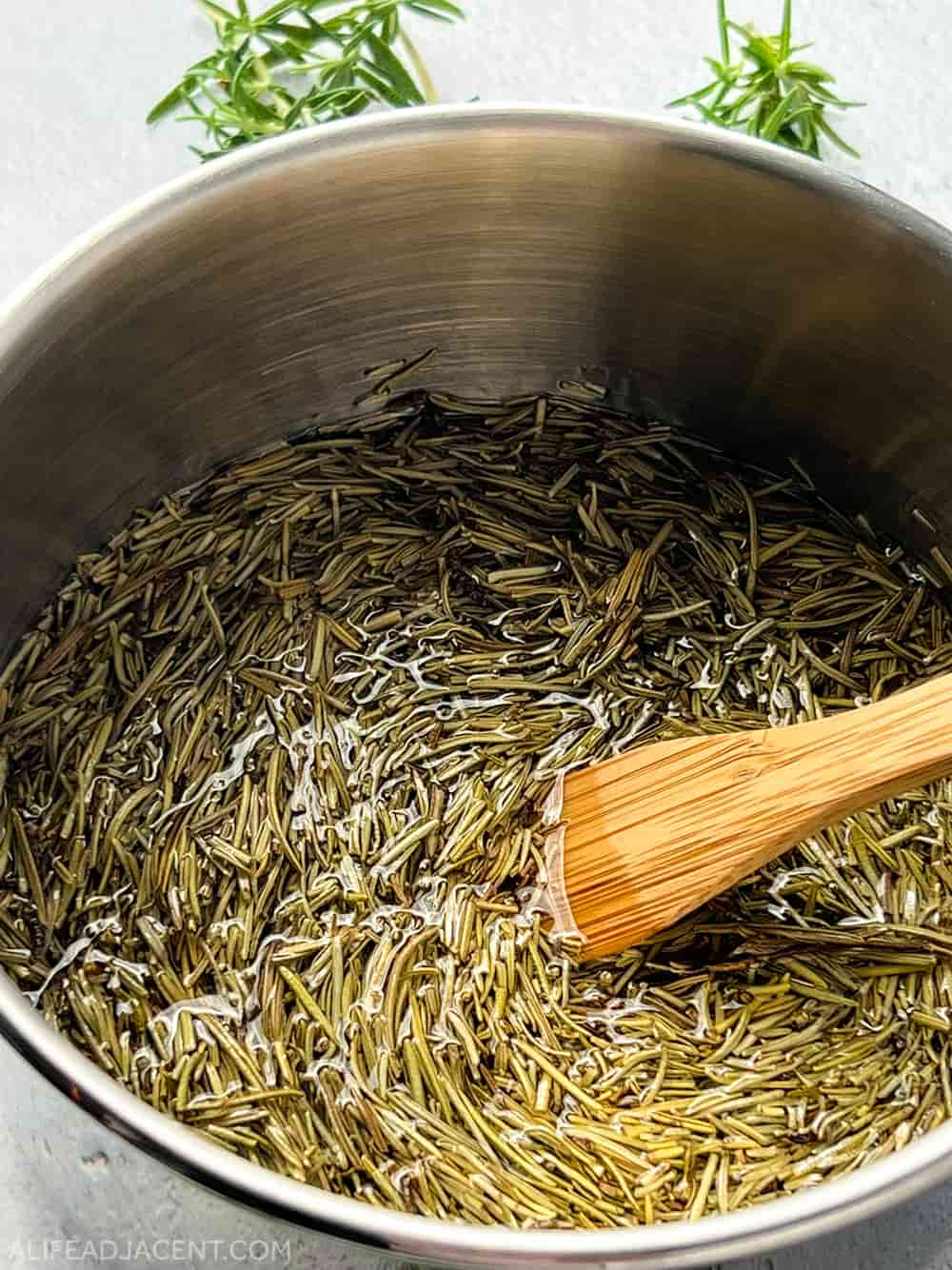
- Once the rosemary oil begins to heat up, shut off the stove, give the oil a stir, and place a lid over the pot to retain the heat. This allows the oil to infuse at a low temperature without needing to check it obsessively. At this point, you can leave and come back to your rosemary oil in about an hour once it cools.
Note: If you don’t have a thermometer, just use your best judgment and don’t exceed medium-low heat. - Every hour or so, come back and repeat this process: once the oil cools, warm it up again on medium-low heat. Then turn off the heat, stir, and replace the lid to allow it to infuse once again.
- Repeat for 4-6 hours. During infusion, the rosemary oil will turn bright golden yellow and become beautifully fragrant. After heating the oil for the final time, don’t replace the lid, and leave the mixture to cool to room temperature.
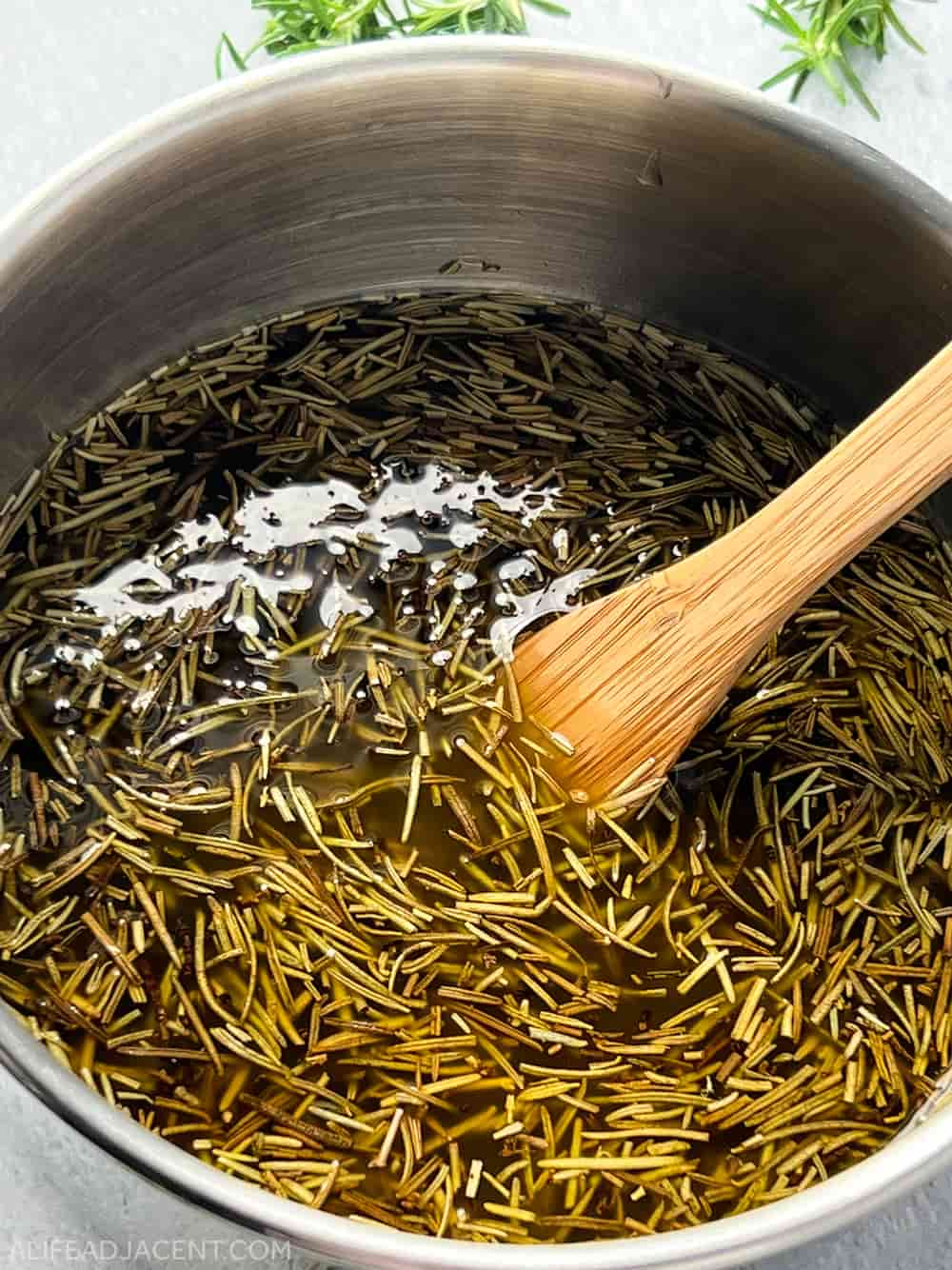
- Once the oil cools, transfer it to a mason jar or another glass container with a lid. Seal it tightly, and place it in a dark, cool cupboard to infuse for at least 2 weeks. The longer you infuse, the more potent it will be. During infusion, your rosemary hair oil may deepen from a bright yellow to a greenish golden hue, depending on how long you leave it. Give the jar a light shake every few days or so to extract the most from your rosemary leaves.

- After 2 weeks, it’s time to strain. Using a sieve, cheesecloth, or both, strain the rosemary leaves out of the infused oil. Whichever method you choose for straining, be sure to squeeze the herbs to release every last drop of infused oil.

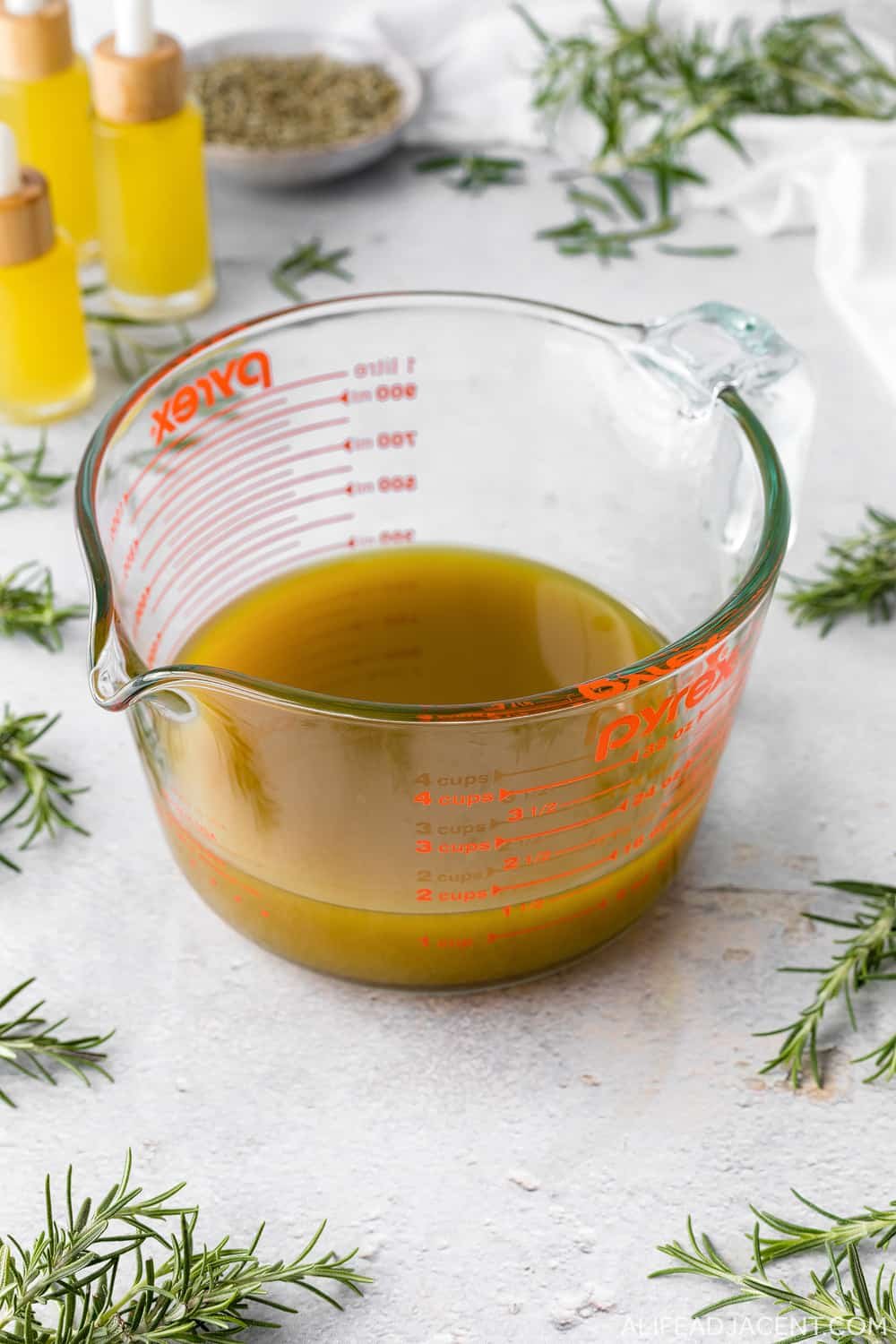
- Once you’ve strained and removed every last particle of debris, transfer your rosemary hair growth oil into a glass dropper bottle. Now, it’s ready to be used directly on the scalp or incorporated into other recipes.

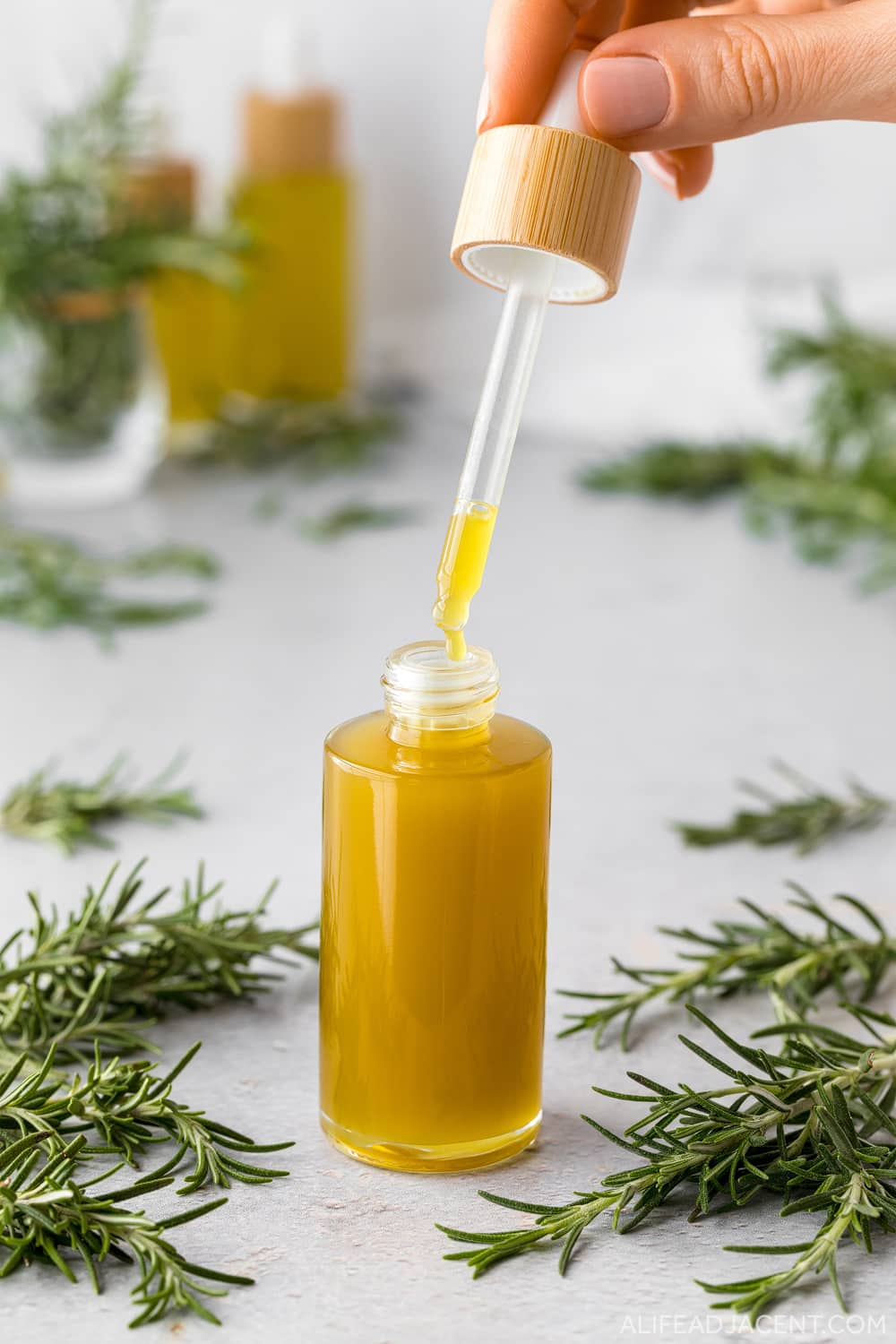
How to dilute rosemary essential oil for hair growth
As mentioned, if you don’t have rosemary leaves or don’t want to go to the trouble of making infused oil, you can also make hair oil with rosemary essential oil.
According to Tisserand and Young’s Essential Oil Safety, rosemary essential oil’s maximum dermal usage is between 6.5%-22%, depending on the type of rosemary oil used20.
There are several different phenotypes of rosemary oil: 1,8-cineole, α-pinene, camphor CT, and verbenone CT, all of which can aid hair growth. A conservative dilution of 5% ensures you will not exceed the maximum usage level.
To dilute rosemary oil for hair, use a maximum of 5ml (1 teaspoon) rosemary essential oil in 1/2 cup (4oz) carrier oil. Place in a glass dropper bottle with 1/2 teaspoon vitamin E oil and shake to combine.
1 teaspoon is approximately 100 drops of essential oils. However, a drop size depends on many factors, including your dropper’s size. Measuring in millilitres prevents you from exceeding a safe level of rosemary oil.
For more exact measurements, use a cosmetic scale to combine 5g rosemary essential oil with 95g carrier oil for a precise 5% dilution.
How to use rosemary extract for hair
If you don’t have rosemary essential oil, you can also use rosemary oil extract. Other names include rosemary oleoresin (ROE) or rosemary CO2 extract.
Rosemary extract is commonly used in packaged food as a stabilizer, preservative, and antioxidant21. It’s particularly high in carnosic acid, a powerful antioxidant that helps promote hair growth by inhibiting DHT and suppressing inflammation.
Rosemary extract is highly concentrated, and too much can irritate the skin, so its maximum usage level is 0.5%. Make sure you choose an oil-based extract, not a water-soluble rosemary leaf extract.
To use, combine 0.5g rosemary extract with 95g carrier oil and use it on your scalp.
How to use rosemary oil for hair growth
Apply the rosemary infused oil to your scalp, massaging it with your fingertips as you go. You can use your bottle’s dropper to squirt the oil directly onto your head. Or, you can dispense the oil into your hands, using your fingertips to gently press it into your scalp.
Work your way around your entire head. Make sure to apply the rosemary oil to your temples and hairline, however, be careful not to get it on your face. Don’t forget to apply it to the back of your head which often gets missed, too.
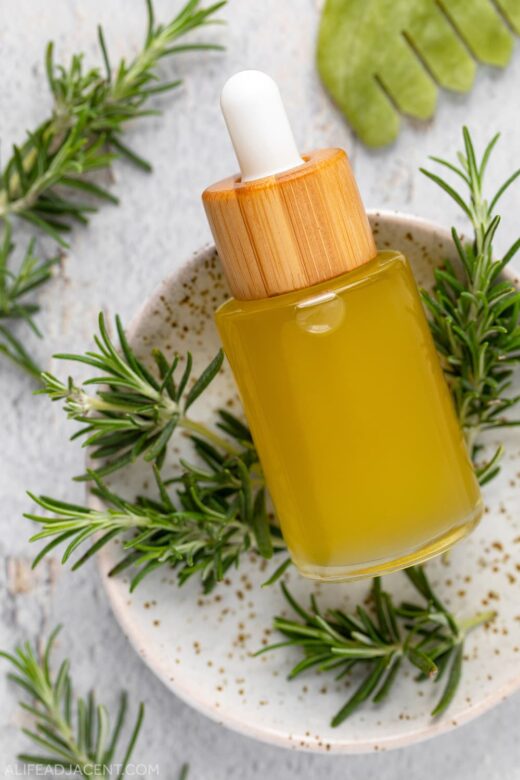
After you’ve saturated your scalp, you can also turn your head upside down and continue the scalp massage – inverting your head diverts blood to the scalp and hair follicles, further stimulating growth. (However, please only do this if this if inversions are safe for you.) Use a massaging gua sha comb for a stronger massage.
Shortly after applying, you’ll feel your scalp pulsating and tingling – that’s rosemary oil’s circulation-promoting effects at work. So you’ll know it’s bringing vital nutrients to your scalp and helping your hair grow!
If desired, you can also pull some oil through the length of your hair to nourish your strands with rosemary’s potent antioxidants.
For best results, leave the rosemary oil on for as long as you can to allow it to work its hair growth magic. Then, wash your hair as normal, and follow it with a rosemary hair rinse for even more growth benefits.
Tips for using rosemary hair oil
- You can apply your rosemary oil to dry or slightly damp hair. If you find that oils tend to dry out your hair, wetting hair first helps lock in moisture.
- It likely goes without saying that if your goal is fast growth, a hair growth oil is best used as often as possible. You can use rosemary oil on your hair every day if you already wash your hair daily. But if you don’t, just apply it according to your usual washing schedule, as often as your lifestyle allows. If that’s only twice a week, that’s fine – just be consistent!
- Consistency is key – you won’t see crazy overnight hair growth with rosemary. As with anything, it’s the small things done on a regular basis that make the most difference.
- This rosemary infused oil is highly concentrated. So while you saturate your entire hair and scalp in it if you wish, you don’t need to use a lot.
- Be mindful of bedding and clothing, as rosemary oil stains.
Here are a few more ideas on how to use your hair oil:
- Apply rosemary oil in the morning on the day you plan to wash your hair, then wash it out at night. If you plan to work out, even better – the gentle heat of your scalp helps the oil permeate even more.
- Can you leave rosemary oil in your hair overnight? Absolutely – apply it before bed and wash it out in the morning. Just be sure to sleep on a pillowcase you don’t care about, as the brightly colored oil will stain bedding.
- Don’t have time to leave the oil in for long? No problem – there’s no need to have a greasy scalp all day to see results. Just try to find at least a couple hours to leave the rosemary oil on your scalp before washing it out.
- If you’re pressed for time or don’t like the feeling of an oily scalp, you can use what I call the “quick method” to apply rosemary oil. Instead of dousing your head, simply use your fingertips to gently press a small amount of oil into your scalp for a light, even coating. This method is useful before going to bed so you don’t turn you pillow into an oil slick.
FAQ
That depends. In the study comparing rosemary oil and minoxidil, it took 6 months to see a significant increase in hair growth and thickness with daily use. However, it only took 3 months for rosemary oil to decrease hair fall. It depends on your unique hair growth cycle and how often you use it.
You can use fresh rosemary to make infused oil, but only if you dry it first.
It’s vital for oil-based products to be anhydrous (free of water), as oil and water together create the perfect conditions for bacteria to thrive.
Fresh rosemary is high in moisture. So if you try to use fresh rosemary to make hair oil, it’ll end up rancid or moldy before you have a chance to use it up.
Place washed and dried rosemary bunches on a baking sheet. Preheat your oven to the lowest possible setting, then turn the oven off to ensure you don’t damage the herbs. Place the herbs in the oven with the power off for 2-4 hours until completely dry. Remove the dried leaves from the stems before using to make rosemary infused oil.
You’ll notice the rosemary oil is cloudy, but that’s not because it’s spoiled. The double heat infusion method liberates fatty acids, terpenes, and other beneficial compounds from the dry rosemary leaves, creating a cloudy oil that you won’t get from cold infusion.
Over time, the oil will separate into 2 layers, as the heavier fatty acids will create a sediment at the bottom. Simply shake it up before using it on your hair and scalp.
Depending on how long you infuse your rosemary oil, there may be some natural color variation between batches. Yours may vary between bright yellow or a deeper greenish-yellow hue.
Often, culinary rosemary oil is infused with fresh rosemary, which creates a vibrant green oil. But there’s a very good reason you don’t want to use fresh rosemary to make hair oil, explained above.
More rosemary hair growth recipes
You might also enjoy these other rosemary-infused recipes for hair:
- Rosemary Water for Hair Growth
- Herbal Hair Growth Oil
- DIY Hair Mask for Growth
- Eyelash Growth Serum
- Eyebrow Growth Serum
- Dry Shampoo Spray Recipe
For More DIY natural haircare, follow us on Pinterest, Instagram, YouTube, Facebook, TikTok, and Twitter.
Pin it for later

- Panahi, Y., et al. “Rosemary Oil vs Minoxidil 2% for the Treatment of Androgenetic Alopecia: A Randomized Comparative Trial.: Semantic Scholar.” Skinmed, 1 Jan. 1970, https://www.semanticscholar.org/paper/Rosemary-oil-vs-minoxidil-2-for-the-treatment-of-a-Panahi-Taghizadeh/ce0063f1a3c69976833b9daa37deadcba6e71ce8.
- Murata, Kazuya et al. “Promotion of hair growth by Rosmarinus officinalis leaf extract.” Phytotherapy research : PTR vol. 27,2 (2013): 212-7. doi:10.1002/ptr.4712
- Lee MY, Na EY, Yun SJ, Lee SC, Won YH, Lee JB. In vitro Study and Clinical Trial of Natural Essential Oils and Extract Against Malassezia Species. Korean J Med Mycol. 2018;23(4):91-98.
- Loussouarn, Margot et al. “Carnosic Acid and Carnosol, Two Major Antioxidants of Rosemary, Act through Different Mechanisms.” Plant physiology vol. 175,3 (2017): 1381-1394. doi:10.1104/pp.17.01183
- Murphrey MB, Agarwal S, Zito PM. Anatomy, Hair. [Updated 2022 Aug 8]. In: StatPearls [Internet]. Treasure Island (FL): StatPearls Publishing; 2023 Jan-. Available from: https://www.ncbi.nlm.nih.gov/books/NBK513312/
- de Macedo, Lucas Malvezzi et al. “Rosemary (Rosmarinus officinalis L., syn Salvia rosmarinus Spenn.) and Its Topical Applications: A Review.” Plants (Basel, Switzerland) vol. 9,5 651. 21 May. 2020, doi:10.3390/plants9050651
- Ghasemzadeh Rahbardar, Mahboobeh, and Hossein Hosseinzadeh. “Therapeutic effects of rosemary (Rosmarinus officinalis L.) and its active constituents on nervous system disorders.” Iranian journal of basic medical sciences vol. 23,9 (2020): 1100-1112. doi:10.22038/ijbms.2020.45269.10541
- Trüeb, Ralph M et al. “Scalp Condition Impacts Hair Growth and Retention via Oxidative Stress.” International journal of trichology vol. 10,6 (2018): 262-270. doi:10.4103/ijt.ijt_57_18
- Davis, M.G., Piliang, M.P., Bergfeld, W.F., Caterino, T.L., Fisher, B.K., Sacha, J.P., Carr, G.J., Moulton, L.T., Whittenbarger, D.J., Schwartz, J.R., Scalp application of antioxidants improves scalp condition and reduces hair shedding in a 24-week randomized, double-blind, placebo-controlled clinical trial. Int. J. Cosmet. Sci. 43, S14– S25(2021). https://doi.org/10.1111/ics.12734
- Trüeb, R.M., Oxidative stress and its impact on skin, scalp and hair. Int. J. Cosmet. Sci. 43, S9– S13(2021). https://doi.org/10.1111/ics.12736
- Dhariwala, MY, Ravikumar, P. An overview of herbal alternatives in androgenetic alopecia. J Cosmet Dermatol. 2019; 18: 966– 975. https://doi.org/10.1111/jocd.12930
- Li, Jing-Jie et al. “The promotion of hair regrowth by topical application of a Perilla frutescens extract through increased cell viability and antagonism of testosterone and dihydrotestosterone.” Journal of natural medicines vol. 72,1 (2018): 96-105. doi:10.1007/s11418-017-1116-3
- Huang, Bo et al. “Melandrium firmum Extract Promotes Hair Growth by Modulating 5α-Reductase Activity and Gene Expression in C57BL/6J Mice.” Annals of dermatology vol. 31,5 (2019): 502-510. doi:10.5021/ad.2019.31.5.502
- Tsai, Tsung-Hsien et al. “Rosmarinus officinalis extract suppresses Propionibacterium acnes-induced inflammatory responses.” Journal of medicinal food vol. 16,4 (2013): 324-33. doi:10.1089/jmf.2012.2577
- Elbanna, Khaled, et al. “Rosemary (Rosmarinus Officinalis) Oil: Composition and Functionality of the Cold-Pressed Extract.” Rosemary (Rosmarinus Officinalis) Oil: Composition and Functionality of the Cold-Pressed Extract, 1 Jan. 1970, https://pubag.nal.usda.gov/catalog/6061975.
- Kravić, Snežana Ž., et al. “Fatty Acid Composition of Rosemary (Rosmarinus Officinalis L.) Leaves.” AGRIS, Institute of Food Technology, Novi Sad (Serbia), 1 Jan. 1970, https://agris.fao.org/agris-search/search.do?recordID=RS2013060075.
- Mysore, Venkataram, and Arpita Arghya. “Hair Oils: Indigenous Knowledge Revisited.” International journal of trichology vol. 14,3 (2022): 84-90. doi:10.4103/ijt.ijt_189_20
- Torii, Eiko, et al. “Expression of Prostaglandin E2 Receptor Subtypes in Mouse Hair Follicles.” Biochemical and Biophysical Research Communications, Academic Press, 25 May 2002, https://www.sciencedirect.com/science/article/abs/pii/S0006291X01962564.
- MITSUO KAMIMURA, NAOKO SASAKI, EFFECT OF TOPICAL APPLICATION OF VITAMIN E ON THE HAIR GROWTH OF RABBITS, THE JOURNAL OF VITAMINOLOGY, 1965, Volume 11, Issue 1, Pages 1-8, Released on J-STAGE February 26, 2010, Online ISSN 2185-2553, Print ISSN 0022-5398, https://doi.org/10.5925/jnsv1954.1
- Tisserand, Robert, and Rodney Young. “Essential Oil Profiles.” Essential Oil Safety, Elsevier, 2014. Crossref, doi:10.1016/b978-0-443-06241-4.00013-8.
- Nieto, Gema et al. “Antioxidant and Antimicrobial Properties of Rosemary (Rosmarinus officinalis, L.): A Review.” Medicines (Basel, Switzerland) vol. 5,3 98. 4 Sep. 2018, doi:10.3390/medicines5030098

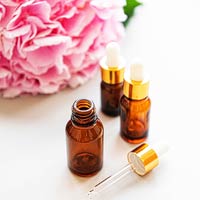
best allergy medications over the counter allergy over the counter drugs alternative allergy treatment options